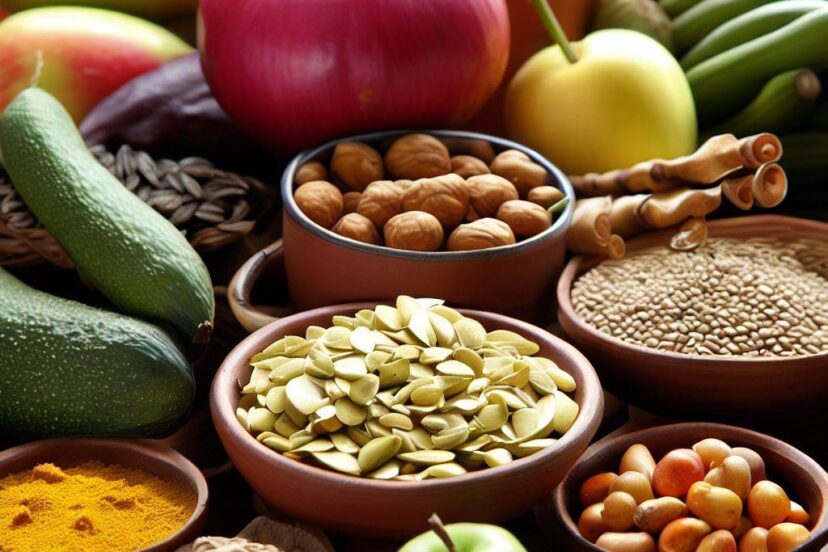Ayurvedic Diet: A Journey Into Ancient Wisdom
*We may earn a commission for purchases made using our links. Please see our disclosure to learn more.
Ayurvedic Diet Essentials: Balancing Your Doshas through Nutrition
Incorporating Ayurveda into daily life can be transformative, and one key aspect is through an Ayurvedic diet, which is more than just a nutritional guideline; it’s a holistic approach to living. This ancient Indian medicinal system teaches that health is maintained by the balance of three doshas — Vata, Pitta, and Kapha — which are dynamic energies that influence both our internal and external environments. My diet, as an Ayurvedic practice, involves eating in accordance with these energies to promote optimal health and well-being.

Understanding my dosha type is crucial when I follow the Ayurvedic diet, as each dosha necessitates specific dietary needs. These foods are not only meant to nourish my body but also to balance my mental and emotional health. I am mindful of the flavors and qualities of foods, emphasizing the consumption of whole foods that enhance my digestive fire, which is central to processing and assimilating nutrients effectively.
I approach eating as a mindful ritual, where I consider the timing, quantity, and quality of food. The emphasis is on fresh meals, involving little to no processed foods, and on eating in a calm environment to aid digestion. By tailoring my food choices to my dosha and practicing mindfulness, the Ayurvedic diet supports me in leading a balanced and healthful life.
Foundations of Ayurvedic Diet

The Ayurvedic Diet is deeply rooted in the principles of Ayurveda that focus on individual balance and dietary personalization. I’ll explain how the three primary life energies or doshas—Vata, Pitta, and Kapha—interact with the elements and tastes to form its foundation.
Understanding the Doshas
In Ayurveda, the concept of doshas is central to understanding our own unique constitution and how it affects our health. Each dosha—Vata, Pitta, and Kapha—corresponds to certain physical and mental characteristics.
- Vata is characterized by properties of air and ether, and it controls movement. If I have a dominant Vata dosha, my diet should focus on grounding and hydrating foods to balance my Vata. These include warm, cooked dishes that are slightly oily and moist.
- Pitta is governed by fire and water. It is the dosha of digestion and metabolism. Individuals with a leading Pitta dosha need to consume cooling and energizing foods that can balance their inner fire. This can be achieved by eating foods that are cool and slightly dry.
- Kapha, a combination of earth and water, embodies structure and fluidity. To balance Kapha, the diet would include stimulating and astringent foods, aiding in digestion and preventing lethargy.
Five Elements and Taste
Each dosha is connected to the five elements—space, air, fire, water, and earth—and these are further linked to the six tastes: sweet, sour, salty, bitter, pungent, and astringent. Every taste has a role in balancing the doshas.
- Sweet, sour, and salty tastes can increase Kapha and decrease Vata and Pitta. I incorporate these tastes cautiously to maintain a balanced diet.
- Bitter, pungent, and astringent tastes do the opposite—they decrease Kapha and increase Vata and Pitta. These tastes are vital for Kapha types to introduce into their diet for balance.
Here is a simple table that categorizes the six tastes and their corresponding elements, which provides a quick reference on how they influence the doshas:
| Taste | Elements | Increases | Decreases |
| Sweet | Earth, Water | Kapha | Vata, Pitta |
| Sour | Earth, Fire | Kapha | Vata, Pitta |
| Salty | Water, Fire | Kapha | Vata, Pitta |
| Bitter | Air, Space | Vata, Pitta | Kapha |
| Pungent | Fire, Air | Vata, Pitta | Kapha |
| Astringent | Air, Earth | Vata, Pitta | Kapha |
Each taste serves to either pacify or exacerbate the doshas, and I find it crucial to consider this when preparing meals to ensure the body remains in a state of balance.
Ayurvedic Dietary Principles

When I examine the Ayurvedic diet, I pay close attention to two main concepts: the critical role of digestion in overall health and the profound interaction between food and the mind.
Importance of Digestion
In Ayurvedic medicine, digestion is referred to as Agni or digestive fire. My understanding of this principle is that a robust Agni is fundamental to converting food into vital energy. For me, maintaining a strong digestive system is crucial as it’s believed to directly impact my health and balance my doshas— the energies that govern physiological functions.
- Key Points:
- Agni (Digestive Fire): A strong Agni is essential for converting food into energy and maintaining overall health.
- Balancing Doshas: Proper digestion is instrumental in balancing the body’s energies, or doshas.
A balanced Agni enables efficient digestion, allowing me to absorb the nutrients from my food effectively, thus supporting my energy levels and well-being. I also recognize that the strength of my digestive fire varies throughout the day, peaking around noon when the sun is at its highest, suggesting that’s the best time for my largest meal.
Food and Mind Connection
My relationship with food goes beyond mere nutrition; it influences my state of mind and emotions. Ayurvedic principles teach me the concept of mindful eating, which emphasizes the importance of being fully present during meals. This practice allows me to appreciate the flavors, textures, and aromas of my food, leading to a more satisfying and emotionally balanced eating experience.
- Key Practices:
- Mindful Eating: I focus on the present moment while eating, savoring each bite to enhance my emotional well-being.
- Emotional Balance: Understanding the connection between the foods I consume and my emotions promotes better mental health.
By integrating these principles into my life, I’ve found I am more in tune with my body’s needs and my mind’s responses to different foods, supporting a harmonious relationship between my diet and mental wellbeing. Recognizing the impact of various foods on my energy, I adapt my diet to support both my physical and emotional health.
Nutritional Guidelines by Dosha
In Ayurveda, attuning one’s diet to one’s Dosha can significantly affect health and well-being. I’ll guide you through what foods to favor and avoid for Vata, Pitta, and Kapha Doshas.
Vata Pacifying Diet
To balance Vata, which is characterized by dryness and mobility, I recommend nourishing, moist, and grounding foods. Fruits that are sweet and heavy, such as bananas and avocados, are beneficial. In terms of vegetables, I favor cooked root vegetables like sweet potatoes and carrots, which provide grounding energy. For grains, cooked rice and oats are ideal. Legumes should be consumed in moderation; mung dal is easily digested and supportive for Vata. When it comes to spices, warming options like ginger and cumin can stimulate digestion without causing irritation.
- Fruits: sweet, heavy fruits like bananas, avocados
- Vegetables: cooked root vegetables like sweet potatoes
- Grains: cooked rice, oats
- Legumes: mung dal
- Spices: ginger, cumin
Pitta Pacifying Diet
To calm Pitta Dosha, emphasis is on cooling and hydrating foods. Fruits should be sweet and not too sour, including favorites like melons and grapes that have a cooling effect. Among vegetables, bitter greens like kale and refreshing options like cucumbers can be soothing. Grains like barley and wheat are cooling, whereas legumes including chickpeas offer proper nourishment without overheating the body. I use spices that are not overly hot, such as coriander and fennel, to encourage digestion while preventing aggravation.
- Fruits: sweet, cooling fruits like melons, grapes
- Vegetables: bitter greens, cucumbers
- Grains: barley, wheat
- Legumes: chickpeas
- Spices: coriander, fennel
Kapha Pacifying Diet
For Kapha types, I focus on stimulating and light foods to counteract the inherent heaviness. Fruits that are astringent like apples and pears are supportive. In the vegetable category, I suggest leafy greens and cruciferous vegetables like broccoli that promote lightness. Grains should be light as well; think quinoa and millet. Legumes are good for Kapha, particularly the astringent types like lentils. When it comes to spices, I recommend invigorating and heating ones such as black pepper and ginger to boost digestion.
- Fruits: astringent fruits like apples, pears
- Vegetables: leafy greens, cruciferous vegetables like broccoli
- Grains: quinoa, millet
- Legumes: lentils
- Spices: black pepper, ginger
Ayurvedic Diet and Foods and Preparations

In Ayurveda, emphasis is placed on selecting whole foods and using specific herbs and spices to balance the body’s doshas. These preparations cater to individual needs and promote overall wellness.
Whole Foods and Cooking with an Ayurvedic Diet
I focus on incorporating a variety of whole foods in my Ayurvedic diet because they are unprocessed and devoid of additives. Fresh, seasonal fruits and vegetables are staples, providing essential vitamins and minerals. Whole grains like quinoa, rice, and barley are commonly used along with proteins such as lentils, beans, and occasionally meat. When cooking, I often use ghee or butter for their nourishing qualities and to aid in digestion.
- Nuts and seeds are valued for their energy-boosting properties. Here’s a typical list of what I might include:
- Almonds
- Walnuts
- Flaxseeds
- Pumpkin seeds
- Recipes in Ayurveda are tailored to be nourishing, and they often include these ingredients cooked rather than raw to improve digestibility.
Herbs and Spices in Ayurveda
I regularly utilize a range of herbs and spices to balance the body’s doshas. These are not just for flavor; they serve specific health purposes:
- Turmeric: Known for its anti-inflammatory properties.
- Ginger: Aids digestion and adds warmth to meals.
- Cumin, Coriander: Both spices are great for digestion and help in balancing various doshas.
| Spice | Property | Dosha Benefit |
| Turmeric | Anti-inflammatory | Balances Kapha, Pitta |
| Ginger | Digestive, warming | Balances Vata, Kapha |
| Cumin | Digestive, cooling | Balances Pitta, Kapha |
| Coriander | Digestive, cooling | Balances Pitta |
- I also prepare herbal teas using a blend of spices and herbs that suit my dosha requirements. This can include combinations like ginger and lemon for its soothing and rejuvenating effects.
Implementing an Ayurvedic Diet in Modern Lifestyle

Incorporating an Ayurvedic diet into my modern lifestyle requires mindfulness about when and what I eat, aligning food choices with the seasons and my body’s needs. I prioritize natural rhythms and local produce to maintain the balance of my doshas.
Meal Planning and Timing
Breakfast: I start my day with a hearty breakfast before 8 a.m., catering to my body’s natural digestive strength which is higher in the morning. My breakfast usually consists of warm and nourishing foods that provide energy without overwhelming my digestive system.
Lunch: The peak time for my digestion is at noon, so I schedule the most substantial meal of my day, lunch, between 12 p.m. to 1 p.m. This meal is a balanced combination of proteins, vegetables, and fats, which stabilizes my energy levels throughout the afternoon.
Dinner: A lighter dinner around 6 to 7 p.m. allows my digestion to work efficiently before the nighttime fast. I ensure it’s a smaller, simple meal to prevent overloading my digestive system before sleep.
Seasonal and Local Eating
Seasonal: My diet changes with the seasons to adapt to the varying needs of my body. For example, during the cold and dry vata season, which often coincides with winter, I include more grounding and hydrating foods. Alternatively, in the hot pitta season, summer, I opt for cooling and less spicy foods to help balance my internal temperature.
Local: I choose locally sourced and organic foods to ensure I’m eating what’s fresh and available in my climate. This not only supports my local economy but also reduces the environmental impact of my food consumption. Eating local means the food is more likely to be in sync with the seasonal needs of my body.
By adhering to these principles, I uphold the Ayurvedic diet’s emphasis on harmony between my lifestyle and the natural world while making choices that foster well-being in my daily life.
Frequently Asked Questions
The Ayurvedic diet is an integral part of Ayurveda, a holistic approach to health that originated in India. It emphasizes balance in all aspects of life, especially diet, which is personalized based on individual constitutions known as doshas.
1. What are the foundational principles of an Ayurvedic diet?
The foundational principles focus on balancing the three doshas – Vata, Pitta, and Kapha. My diet must include six tastes: sweet, sour, salty, bitter, pungent, and astringent, which correspond to the elemental qualities of the doshas.
2. How can one identify their dosha type to customize an Ayurvedic diet?
I can identify my dosha type through a detailed assessment of my physical characteristics and mental tendencies, often conducted by an Ayurvedic practitioner. Self-assessment quizzes are available, which can provide a preliminary understanding of my dominant dosha.
3. What types of foods are typically included in an Ayurvedic diet food list?
The food list generally consists of fresh, seasonal whole foods. This includes fruits, vegetables, grains, legumes, nuts, seeds, and dairy. Animal proteins are used sparingly. Foods are chosen for their ability to balance my dosha.
4. How does an Ayurvedic diet vary for different dosha types?
For Vata types, warming and grounding foods are recommended; for Pitta types, cooling and moderately dry foods are favored; while for Kapha types, stimulating and light foods are beneficial. Each dosha has specific needs to maintain balance.
5. What are some common Ayurvedic dietary practices for maintaining balance and health?
Common practices include eating three regular meals at specific times each day, incorporating all six tastes in each meal, and selecting foods according to the season and my dosha type. Drinking warm water, especially in the morning, is also encouraged.




